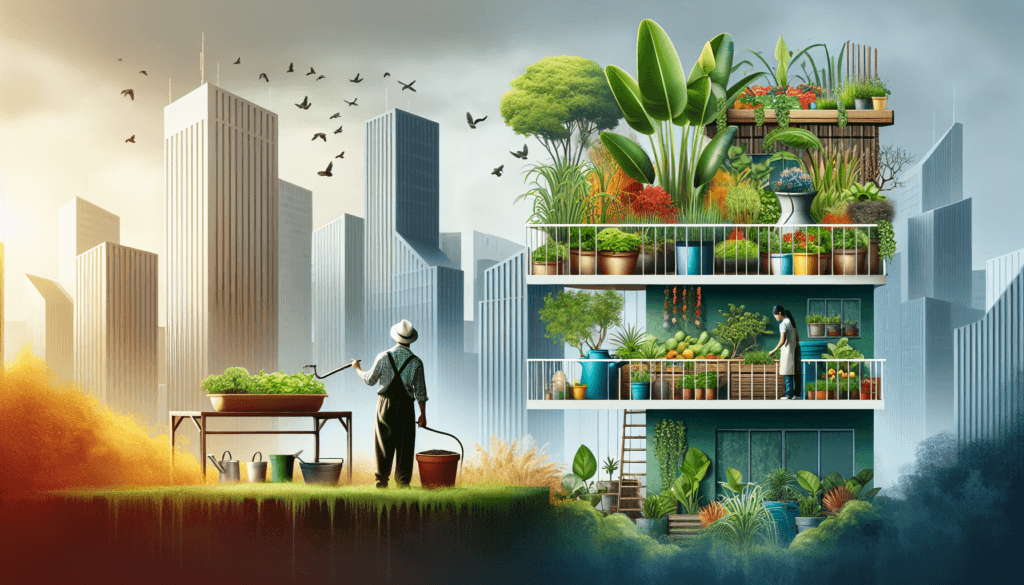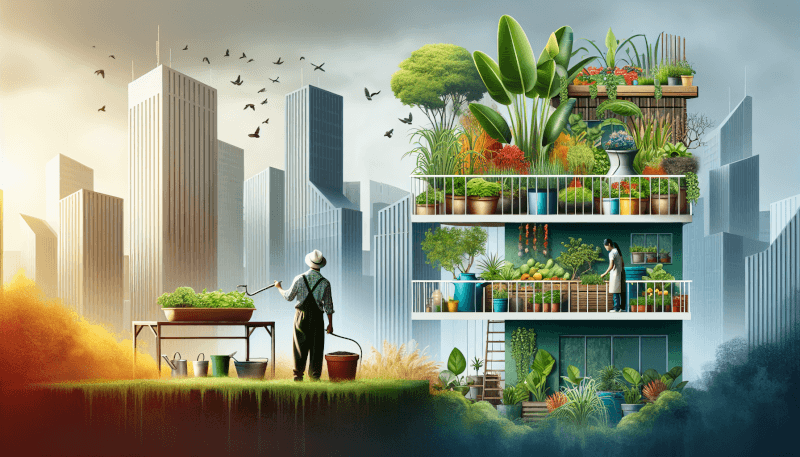City gardening has become increasingly popular in recent years, and for good reason. It offers a chance to reconnect with nature amid the hustle and bustle of urban life. However, this urban oasis does come with its fair share of challenges. From limited space to poor soil quality, navigating the world of city gardening requires creativity, determination, and a willingness to adapt. In this article, we will explore some of the common challenges faced by city gardeners and provide tips and strategies to help you overcome them. So, if you’re ready to turn your concrete jungle into a lush green haven, read on!

Limited Space
In a city, finding available land for gardening can be a major challenge. With the population constantly increasing, there is a limited amount of open space for gardening. Industrialization and urbanization have taken over much of the previously available land, leaving little room for green spaces. This lack of available land makes it difficult for urban dwellers to pursue their passion for gardening.
Additionally, even the small gardening areas that do exist in cities often face intense competition for space. Residents may have to contend with other gardeners in their neighborhood, all vying for the limited garden plots or community gardens. This can create a sense of frustration and disappointment, as many people are unable to secure a spot to cultivate their own plants.
Poor Soil Quality
One of the major challenges in city gardening is the poor quality of soil. Contaminated soil can be a significant issue in urban areas. Industries, traffic, and other human activities release pollutants into the environment, which can then seep into the soil. This contaminated soil poses a risk to the health of plants and can inhibit their growth.
Additionally, city soil is often lacking in essential nutrients necessary for plant growth. Due to the constant human activity and development, the natural ecosystem and nutrient cycle may be disrupted. This means that plants may not receive the necessary nutrients to thrive, resulting in stunted growth or nutrient deficiencies.
To overcome these challenges, urban gardeners often need to invest time and effort into soil amendments. Adding organic matter, such as compost or fertilizers, can help improve the soil quality and provide the necessary nutrients for plants to grow successfully.
Limited Sunlight
Another significant challenge for city gardeners is the limited access to sunlight. Tall buildings and shadows cast by these structures can obstruct the sunlight, reducing the amount of light that reaches the plants. This is especially true in densely populated areas where high-rise buildings dominate the skyline.
The reduced sunlight can have a detrimental impact on plant growth. Sunlight is vital for the process of photosynthesis, through which plants convert light energy into chemical energy. If plants do not receive enough sunlight, they may struggle to produce food and grow to their full potential.
Urban gardeners need to strategically plan their garden layouts and choose appropriate plant varieties that can tolerate shade or thrive in low-light conditions. Options such as shade-tolerant plants, indoor gardening, or vertical gardening may be necessary to make the most of the limited sunlight available in urban environments.
Watering Challenges
Water availability and restrictions can present significant challenges for city gardeners. Limited water sources in urban areas can make it difficult to provide plants with adequate hydration. With the rise in water scarcity and the growing demand for water in cities, gardeners may need to find alternative water sources or rely on water-saving techniques.
Furthermore, many cities have implemented water restrictions to conserve this valuable resource. These restrictions may limit the frequency or volume of water that can be used for gardening, making it challenging to keep plants properly watered. Urban gardeners must be mindful of these restrictions and find innovative ways to optimize water usage, such as using drip irrigation systems or collecting rainwater.
In addition to limited water availability, urban gardens often face drainage issues. Paved surfaces and lack of permeable spaces can lead to poor drainage, causing water to accumulate and potentially drown the plants. Proper drainage must be addressed to prevent waterlogging and ensure the health and survival of the plants.
Pest Control
Urban gardening often brings about an increase in pest populations due to the proximity of green spaces and human activity. In cities, the availability of food sources and favorable environments for pests can create ideal conditions for infestations. Without natural predators in urban environments, pests can rapidly multiply and wreak havoc on gardens.
Urban gardeners face the challenge of having limited natural predators to control these pests. In rural areas, birds, reptiles, and insects serve as natural pest control agents. However, in cities, the presence of these predators may be scarce, leading to a higher prevalence of pests such as aphids, slugs, or rats.
Moreover, damage caused by animals can be another significant challenge for city gardeners. Urban gardens are often vulnerable to animals like squirrels, raccoons, or stray cats, who may dig up plants or feast on the harvest. Protective measures such as fencing, netting, or deterrents may be necessary to minimize the impact of these pests on urban gardens.
Noise and Air Pollution
City gardening comes with the challenge of exposure to loud noises and airborne pollutants. Urban areas are characterized by high levels of noise pollution due to traffic, construction, and various human activities. Noise pollution can have negative effects on plant growth and development. Studies have shown that prolonged exposure to high noise levels can result in reduced plant growth, altered flower and fruit development, and impaired nutrient uptake.
Air pollution is another concern for urban gardeners. The emissions from vehicles, factories, and other industrial activities release pollutants such as nitrogen dioxide and particulate matter into the air. These pollutants can settle on plants, blocking the stomata, or tiny pores, through which plants exchange gases. As a result, plants may have difficulty in photosynthesis, nutrient absorption, and overall growth.
To mitigate the impact of noise and air pollution, urban gardeners may need to consider green space planning and strategically create buffers or barriers to reduce exposure to noise and pollutants. Additionally, using air-purifying plants or implementing proper ventilation and filtration systems can help combat air pollution and protect the health of urban gardens.
Limited Plant Varieties
The limited space available for gardening in urban areas often means that only a few plant varieties can be grown. There is simply not enough room for expansive gardens with diverse plant species. This limitation can hamper biodiversity and restrict the variety of plants that urban gardeners can cultivate.
Additionally, the availability of seeds and plants may be limited in urban environments. Garden centers and nurseries in cities often offer a narrower selection compared to rural areas. This can limit the choices for urban gardeners and make it more challenging to find the specific plants or varieties they desire.
Adapting plants to the urban environment is crucial for successful city gardening. Urban gardeners tend to choose plant varieties that can thrive in limited space, tolerate shade, pollution, and drought conditions. Selecting compact plants, dwarf varieties, or vertical gardening techniques can maximize the potential for a diverse plant collection within the limited urban landscape.
Community Involvement
Urban gardening can face challenges related to community involvement. Many city dwellers have limited gardening knowledge, resulting in reluctance or hesitation to engage in gardening activities. The lack of gardening knowledge and experience may deter individuals from participating in community gardening projects or starting their own urban gardens.
Moreover, limited participation in community gardening projects can be a significant hurdle. A lack of interest, time constraints, or conflicting schedules may hinder community members from actively engaging in these initiatives. Building a sense of community and fostering collaboration can help overcome these challenges. By organizing workshops, educational programs, or community events, urban gardeners can inspire and motivate others to join in the gardening journey.
Social dynamics and conflicts within communities can also pose challenges in urban gardening. Differences in gardening styles, plant choices, or gardening practices can lead to tensions or conflicts among gardeners. Open communication, active listening, and mutual respect are essential to maintaining a harmonious and inclusive community gardening environment.
Maintenance and Upkeep
City gardening requires regular maintenance and upkeep to ensure the health and vitality of the plants. Gardens need proper care, including watering, weeding, pruning, and pest control. However, in urban areas, accessing gardens can be challenging, especially if they are located on rooftops, balconies, or in communal spaces.
Furthermore, the maintenance and upkeep of urban gardens can be a financial and time commitment. Urban gardeners may need to invest in tools, equipment, and materials to maintain their gardens. Additionally, the demands of daily urban life, such as work, commuting, and family responsibilities, may restrict the time available for gardening activities.
Overcoming these challenges requires innovative solutions and time management strategies. Implementing low-maintenance gardening techniques, such as xeriscaping or companion planting, can help reduce the workload and make gardening more feasible for urban dwellers. Collaborative maintenance efforts, where community members share responsibilities, can also alleviate the burden on individual gardeners.
Conclusion
City gardening brings with it a unique set of challenges that urban dwellers must contend with. Limited space, poor soil quality, limited sunlight, watering challenges, pest control, noise and air pollution, limited plant varieties, community involvement, and maintenance and upkeep are all hurdles to be overcome.
However, with creativity, adaptability, and community involvement, these challenges can be turned into opportunities for an abundant and thriving urban garden. By addressing these challenges head-on, urban gardeners can enjoy the benefits of nurturing green spaces, cultivating fresh produce, and fostering a sense of community amidst the bustling cityscape. So, go ahead, embrace the challenges, and start your urban gardening journey with a friendly spirit and a determination to create a green oasis in the midst of the urban jungle.


